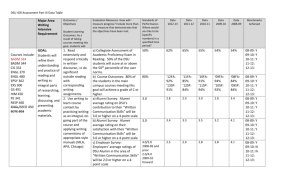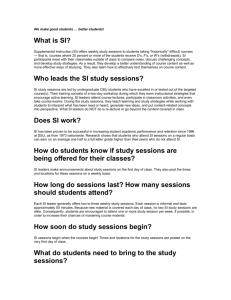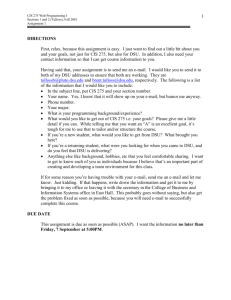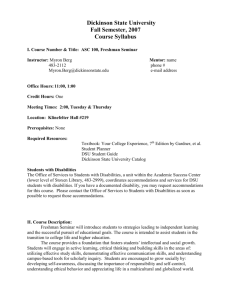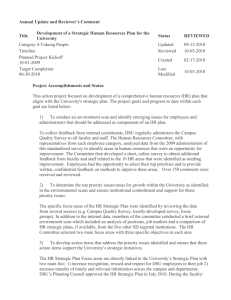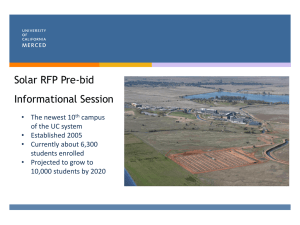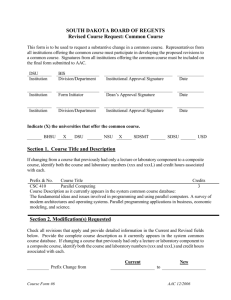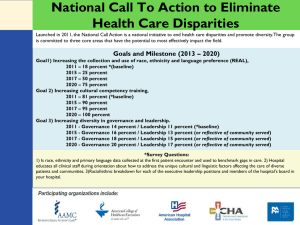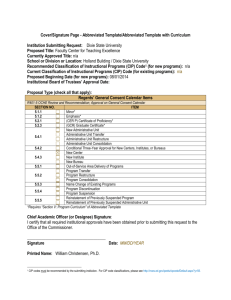ExcEllEncE through InnovatIon
advertisement
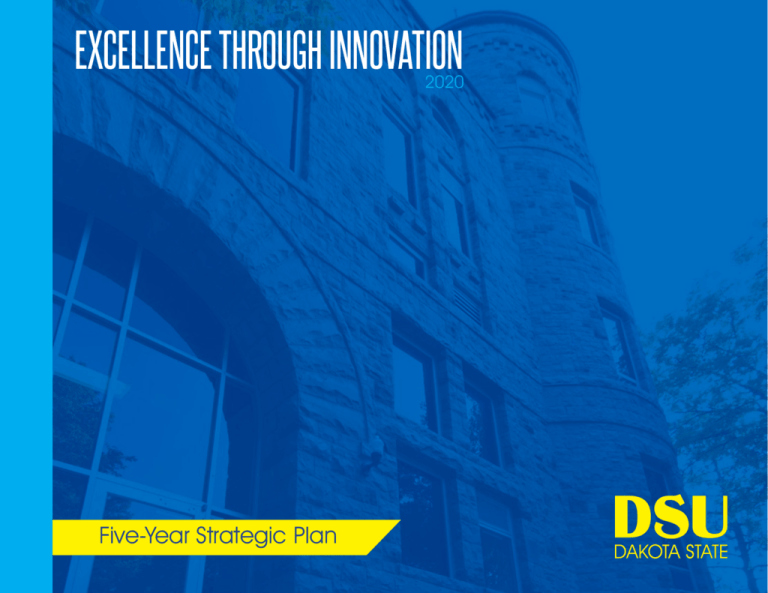
Excellence through Innovation 2020 Five-Year Strategic Plan 1 Developed collectively by university stakeholders, Excellence through Innovation 2020 functions as a strategic guide for our students, university, and community. Our process Excellence through Innovation 2020 has been developed in consideration of DSU’s: DSU’s primary assets lie in a growing reputation for excellence, the technology-enhanced quality programs we offer, and the students those programs attract. These qualities are enhanced through our committed faculty, staff, and administration. DSU’s reputational capital is built on our technology-rich, discipline-focused educational programs. DSU meets the talent needs of both South Dakota and the surrounding region in cyber security, business, finance, K-12 education, digital arts, and healthcare sectors. We are committed to providing educational opportunities that empower our students to enrich their communities through innovative thought and action. 133 year history starting as a Normal School and then becoming a comprehensive public institution with a wide variety of majors. Explicitly-defined legislative mission which integrates technology across the curriculum through unique degree options delivered by an outstanding and dedicated faculty and staff; and Grounded in a spirit of continuous improvement, the DSU community is committed to our students’ success, our distinctive mission, and university-wide excellence. DSU is dedicated to the personal and professional development of a diverse campus community of students, faculty, and staff. The university contributes to an exceptionally welcoming and intentionally inclusive, accessible campus community, and inspires educational, personal, social, and professional achievement. History of continuous improvement. This strategic plan highlights our strengths, considers our challenges, honors our prior investments and achievements, and reflects widespread stakeholder involvement into the planning process. 2 History & Background Excellence through Innovation 2020 is the result of a 20-month process that is notable for its grass-roots approach. On Wednesday, October 2, 2013, 259 DSU employees, students, and community members attended Listening Day to begin work on the university’s new Strategic Plan. There were 26 groups, facilitated by DSU faculty and staff, who met to discuss campus values, marketing mission, and a university vision. Summaries and updates were dispersed to the campus community immediately. Excellence through Innovation 2020 is grounded in the results from Listening Day and from subsequent and ongoing campus unit planning activities and reviews. Since being selected as the state’s technology university in 1984, the DSU community has strived to create a culture and core curriculum that inspires students, faculty, and staff to be forwardthinking. Fostering true innovation and leadership requires a balance between the technology of the moment and the technology of the future. Excellence through Innovation 2020 builds on previous strategic goals and places stronger emphasis on quality improvement, human resources, and community excellence. The plan recognizes the critical role played in having a diverse and inclusive community, both within the university and in its relationship to the region and the state. 3 4 Our Mission DSU provides learning that integrates technology and innovation to develop graduates ready to contribute to local, national, and global prosperity. Our Vision Building upon its distinctive mission, DSU will become: u The university of choice for those seeking a student-centered institution that offers innovative programs grounded in teaching, research, technology, scholarship, and service excellence. uAn academic community that serves as an economic engine in local, national, and global markets. uA campus recognized for its achievements in continuous quality improvement. 5 Our Values u Student Success. u University-wide Excellence. u Distinction in Teaching, Scholarship, and Service. u Academic Freedom and Integrity. u Diversity, Respect, and Inclusion. u Continuous Improvement. u Community, Collaboration, and Communication. u Technology and Innovation inside and outside the classroom. 6 University Goals Educate to Inspire: Grow to Thrive: Dedicated to Academic Quality and Excellence. Dedicated to Student Access and Success. Innovate to Transform: Collaborate to Lead: Dedicated to Continuous Improvement. Dedicated to Internal and External Partnerships. 7 Educate to Inspire: Dedicated to Academic Quality and Excellence. DSU promotes active engagement in scholarship, teaching, and learning to prepare students to excel in their disciplines and be leaders in their communities. Initiatives: u Initiative 1: Offer innovative and robust academic programs that link to our mission. Performance Indicator Baseline: 2014 Target: 2020 Accredited academic programs 20 23 Programs that receive accreditation through state and national accrediting agencies. Discipline-specific advisory boards 3 6 Formally-organized external advisory boards that provide input into the delivery of academic programs. u Data Definition/Source Initiative 2: Advance inquiry, scholarship, research, and creative activity. Performance Indicator Baseline: 2014 Target: 2020 Baseline set Fall 2015 Target set Fall 2015 Grants/contracts awarded $2,094,768 $2,304,244 Value of grants and contracts awarded through federal, state, local, and private agencies. Proposals submitted $9,423,514 $10,365,965 Value of proposals submitted through federal, state, local, and private agencies. Annual grant and contract expenditures $4,002,828 $6,000,000 All external grants and contracts expenditures by fiscal year. University-recognized citations and publications, regional and national awards, conference activities, and field exhibits 8 Data Definition/Source Data collected through EndNote institutional repository service. u Initiative 3 : Provide opportunities for experiential learning within the curriculum. Performance Indicator Students involved in National Student Exchange program, international travel, and study abroad Student perception of reflective and integrative learning Programs with an experiential learning component u Target: 2020 12 27 First-year: 30.2 Senior: 33.0 First-year: 32.9 Senior: 36.7 Data collected through the National Survey for Student Engagement (NSSE). 95% Percentage of baccalaureate degrees that include an internship, practicum, capstone course, field experience or cooperative learning program. 80% Data Definition/Source DSU students participating in short- and long-term national and international travel experiences. Initiative 4: Infuse innovative technology in the delivery of academic programs. Performance Indicator Student perception of the integration of technology into the curriculum Technology innovation committee established u Baseline: 2014 Baseline: 2014 Target: 2020 3.5 3.8 No committee exists Highly functioning committee Data Definition/Source DSU-specific questions on IDEA faculty evaluation surveys aggregated on a 4-point scale. Committee created to provide faculty support in infusing innovative technology into the curriculum. Initiative 5: Support clear and defined learning outcomes to ensure that DSU graduates are competitive in their fields. Performance Indicator Baseline: 2014 Target: 2020 Major-field assessment plans 85% 100% Assessment plans will utilize direct measures as prescribed by the Higher Learning Commission. Alumni satisfaction with academic programs 77% 82% Data collected from the DSU Alumni Surveys. Percentages represent a rank of excellent or above average. Undergraduate placement rates 95% 96% Information collected annually by the Office of Career Services as a part of the Graduate Outcome Data Report. 9 Data Definition/Source Grow to Thrive: Dedicated to Student Access and Success. By improving access and opportunity, DSU will enroll, retain, and graduate a larger, more diverse student body. Initiatives: u Initiative 1: Optimize undergraduate and graduate enrollment. Performance Indicator Baseline: 2014 Incoming undergraduate full-time degree-seeking students Freshmen: 269 Transfer: 119 Target: 2020 UG: 1180 GR: 78 Off-campus undergraduate and graduate enrollment UG degree seeking: 600 UG non-degree seeking: 956 GR degree seeking: 186 GR non-degree seeking: 47 Undergraduate retention Includes full-time and incoming undergraduate students in the Fall semester. On-campus enrollment consists UG: 1850 of undergraduate and graduate GR: 90 full-time and part-time students. UG degree-seeking: 800 Students in this category are UG non-degree seeking: 960 not enrolled in a main campus GR degree-seeking: 200 course, and may be part-time GR non-degree-seeking: 60 or full-time students. Retention is based on the number of first-time, full-time, baccalaureate, degree-seeking 70% Freshmen freshmen as well as full-time 76% Transfers transfers that begin Fall semester and return the following Fall semester. Freshmen: 450 Transfer: 200 On-campus undergraduate and graduate enrollment 65% Freshmen 71% Transfers 10 Data Definition/Source u Initiative 2: Recruit a more diverse student, faculty, and staff population. Performance Indicator Diversity among graduate and undergraduate student populations Diversity of faculty and staff u Target: 2020 UG: Domestic ethnic diversity: 14% Female: 46% International: 1% UG: Domestic ethnic diversity: 18% Female: 50% International: 2% GR: Domestic ethnic diversity: 17% Female: 30% International: 27% GR: Domestic ethnic diversity: 20% Female: 40% International: 30% Faculty: Domestic ethnic diversity: 6% Female: 38% International: 4% Faculty: Domestic ethnic diversity: 8% Female: 40% International: 6% Staff: Domestic ethnic diversity: 4% Female: 66% International: 0% Staff: Domestic ethnic diversity: 6% Female: 66% International: 2% Data Definition/Source Diversity includes gender and ethnic diversity of full-time and part-time undergraduate and graduate students on campus and online. Ethnic diversity is defined as any student of color as well as international students. Information collected through employee surveys and applications. Faculty and/or staff in these categories have self-identified their classifications. Initiative 3: Support a quality co-curricular educational experience. Performance Indicator Students’ participation in out-of-classroom experiences Students involved in university-sponsored programs u Baseline: 2014 Baseline: 2014 Target: 2020 5.64 6.00 Baseline set Fall 2015 Target set Fall 2015 Data Definition/Source Based on data collected through the Student Satisfaction Inventory (SSI) on a 7.0 Likert scale. Student involvement in recognized student organizations, athletics, theatre, and music. Initiative 4: Create a campus environment that supports student engagement and learning. Performance Indicator Baseline: 2014 Target: 2020 Comprehensive student success model developed, implemented, and evaluated Develop in Fall 2015 Implemented and evaluated The model will be developed by the Student Success Committee and endorsed by general faculty, student government, CSA Council, and Vice President’s Council. Learning Engagement Center established No center on campus Center constructed A center that provides a centralized location for academic advising and tutoring. Master plan developed Construct the Beacom Institute, renovate residence halls, the Trojan Center, and East Hall, and upgrade classrooms Campus master plan implemented 11 Data Definition/Source Construction or renovation of any facilities identified in the campus master plan. Innovate to Transform: Dedicated to Continuous Improvement. Continuously enhance our academic programs, university facilities, student services, and campus technologies to become a more effective and efficient university. Initiatives: u Initiative 1: Focus on maximizing cost-effectiveness and supporting the development of new revenue sources to support the university’s mission. Performance Indicator Baseline: 2014 Target: 2020 Additional revenue sources 0 5 Model initiated Model developed and implemented $309 per credit hour $300 per credit hour Cost to deliver academic programs Total expenditures per credit hour u Data Definition/Source Non-academic programs or services that generate new or additional revenue for the university. A model is developed that analyzes the revenue and costs of each academic program. Metrics will be calculated utilizing academic and support services expenditures per credit hour. Initiative 2: Through continuous quality improvement, DSU will evaluate university-wide processes to promote a student-friendly environment. Performance Indicator On-campus student satisfaction with service excellence Online student satisfaction with service excellence Continuous Quality Improvement (CQI) campus projects Faculty/staff trained in CQI Baseline: 2014 Target: 2020 Data Definition/Source 5.48 6.00 Noel-Levitz Student Satisfaction Inventory (SSI) nationally normed survey administered once every two years to on-campus undergraduate students; survey measured on a 7 point Likert scale. Academic services: UG-5.55; GR-5.56 Instructional services: UG-5.51; GR-5.56 Enrollment services: UG-5.89; GR-5.79 Academic services: UG-6.0; GR-6.0 Instructional services: UG-6.0; GR-6.0 Enrollment services: UG-6.0; GR-6.0 Noel-Levitz Priorities Survey of Online Learners (PSOL) nationally normed survey administered once every two years to online undergraduate and graduate students; survey measured on a 7 point Likert scale. Quality Circles completed: 32 PIEDs completed: 11 Annual count of projects endorsed by CQI Quality Circles completed: 42 Committee and, when applicable, Vice President’s PIEDs completed: 21 Council. 68% 80% 12 Percentage of new faculty and staff that have completed training on campus. u Initiative 3: Create a campus culture that promotes transparent decision making, effective communication, and shared governance. Performance Indicator Baseline: 2014 Target: 2020 Faculty and staff satisfaction with communication, job satisfaction/support and shared governance Communication: 54% Job satisfaction: 74% Shared governance: 64% Communication: 65% Job satisfaction: 78% Shared governance: 70% Satisfaction in each category is measured through the Great Colleges to Work For survey conducted every other year. Overall satisfaction with workplace experience 63% 70% Satisfaction is measured through overall score (comprised of 15 categories) in the Great Colleges to Work For survey. u Data Definition/Source Initiative 4: Improve brand awareness regionally, nationally, and globally. Performance Indicator Baseline: 2014 Target: 2020 University-wide publications 52 110 Twitter followers:1338 Facebook likes: 2200 Website: 286,677 users Twitter followers: 2000 Facebook likes: 3000 Website: 300,000 users Digital media viewed by external audiences 13 Data Definition/Source External publications including magazines, newsletters, press releases, and other materials not related to admissions. Visitors to website and followers on Facebook, Twitter, and other social media. Collaborate to Lead: Dedicated to External and Internal Partnerships. By fostering collaborative relationships with internal and external stakeholders, DSU will expand educational opportunities for students. Initiatives: u Initiative 1: Develop a robust University Advancement program that increases resources for scholarships, facilities, and faculty/staff development. Performance Indicator Endowment assets Percentage of alumni giving Annual giving u Baseline: 2014 Target: 2020 Data Definition/Source $9,794,185 $14,000,000 Value of endowment assets at the end of fiscal year. 12% 14% Metrics calculated by dividing number of alumni donors with number of alumni identified in database. $520,000 $750,000 Annual giving will include dollars raised for scholarships and unrestricted funds. This category will not include any major gifts connected to facilities. Initiative 2: Expand industry, government, and K-12 partnerships to enhance the student educational experience. Performance Indicator Baseline: 2014 Target: 2020 Employers who work closely and regularly with the Office of Career Services 44 69 Employers who conduct interviews, attend career fairs, work with university staff to place students. Collaborative arrangements and agreements between DSU and K-12 school districts 1 15 Formal agreements between DSU and K-12 school districts as part of the new yearlong experience. 14 Data Definition/Source u Initiative 3: Increase alumni involvement through university-wide programs that engage both current and former students. Performance Indicator Baseline: 2014 Target: 2020 Alumni events sponsored 10 26 All alumni office-sponsored programs and events. Alumni communication opportunities 43 78 Communication includes newsletters, emails, special occasion correspondence, and magazines. 15 Data Definition/Source DAKOTA STATE UNIVERSITY 820 N. Washington Ave. Madison, SD 57042 1-888-378-9988 www.dsu.edu 16
